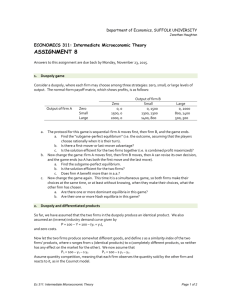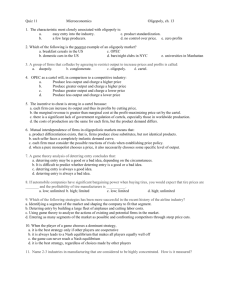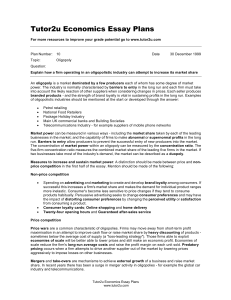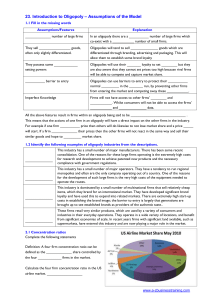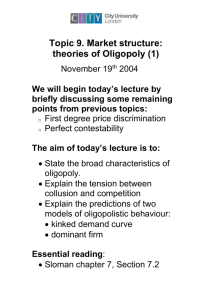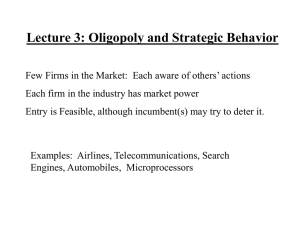AP Microeconomics
advertisement
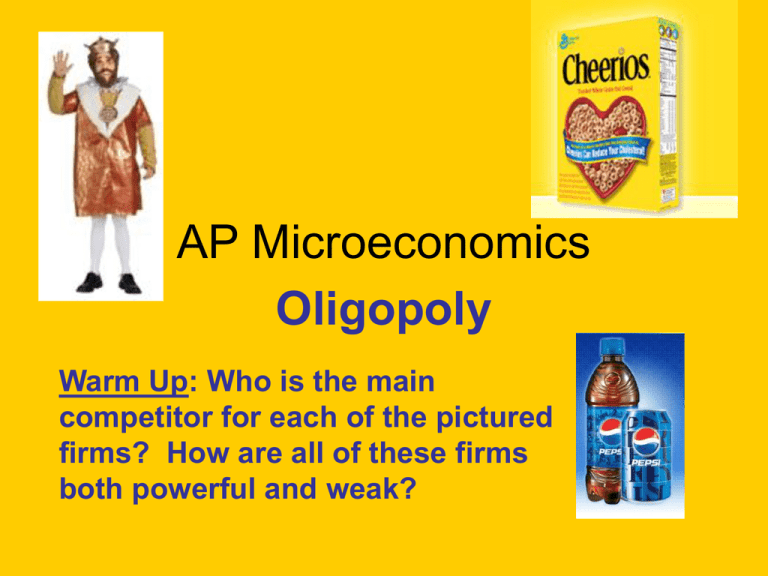
AP Microeconomics
Oligopoly
Warm Up: Who is the main
competitor for each of the pictured
firms? How are all of these firms
both powerful and weak?
Oligopoly Characteristics
An industry with a small number of firms
selling a standardized or differentiated
product; these few firms control at least
2/3’s (67%) of the industry collectively.
Significant pricing power (Lerner Index)
Significant barriers to entry; sheer size of
the few firms prevents others firms from
entering the market (Herfindahl Index)
Oligopoly Characteristics
• Examples include:
– Airlines
– Soft drinks
– Car Manufacturers
– Car tires
– Beer
– Cereal makers
• Unlike Perfect Competition that are so small that
they have no effect on each other and
monopolies that face an entire market alone,
oligopolistic firms must consider the reactions
of their rivals to marketing decisions.
Oligopoly Models:
•
1.
2.
3.
4.
There are four different models that all
represent oligopolies (a few firms
dominating the industry).
Collusion Model
Kinked Demand Curve Model
Duopoly
Price Leadership
1. Collusion Model
a) The small group of
controlling firms
conspire on price and
output and the result
is exactly the same
as it would be if a
monopoly controlled
the entire industry
{ P (MR = MC) }
b) Ex) Cartels like
OPEC
MC
Price
&
Cost
PX
ATC
Profit
Demand
QX
MR
Output
2. Kinked Demand Curve Model
a. The demand curve facing Price
each individual firm has a &
“kink” in it.
Cost
b. Firms will follow each
PX
other if they cut prices
but not if they raise prices
c. The demand above P is
Profit
elastic and raising prices
will decrease total
revenue
d. The demand below P is
inelastic and changing
price will see little
change in demand for
products
MC
ATC
Demand
QX
MR
Output
More Oligopoly Models
(3)
Duopoly (Cournet
Model)
a. Two firms
controlling market
b. Was once a
monopoly but
another firm was able
to grasp some of the
market
(4)
Price
Leadership
a. There is a dominant
firm and this firm will
change price and the
others will be forced
to follow
Strategy!!!
Because oligopolies follow one another, they must
strategize as to what the competition is always
doing!!
John Nash
“A Beautiful Mind”
• Game Theory:
• Considers the strategic decisions of
“players” in anticipation of their rival’s
reaction.
• Often illustrated in a payoff matrix. Let’s Play:
What would you do?
B
O
B
LIZ
Raise
Lower
Raise
400, 300
-800, 500
Lower
600, -800
-500, -500
Dominant Strategy:
Bob = Lower: chance
the strategy that is the best
to make most or lose
regardless of what the opponent
least
does.
Player 2
Player 2
chooses Left chooses Right
Player 1
chooses Up
Player 1
chooses Down
4, 3
–1, –1
0, 0
3, 4
#1: Earn the Most Points
#2: Do Not Let your Opponent
Win!!
Cooperate Defect
Cooperate
2, 2
0, 3
Defect
3, 0
1, 1
Do you cooperate with police or lie (defect)
The numbers represent extra years in prison
you get for attempting an escape; so you want
the least amount of years!!!
As times get more complicated:
ROCK~PAPER~SCISSORS!!!
Is there a dominant strategy?



